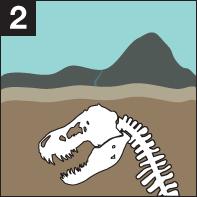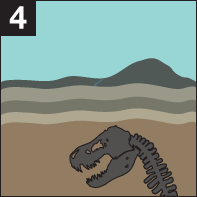Fossils

Fossils are evidence of ancient life forms or ancient habitats which have been preserved by natural processes. They can be the actual remains of a once living thing, such as bones or seeds, or even traces of past events such as dinosaur footprints, or the ripple marks on a prehistoric shore. Geologists can tell the age of a fossil through a variety of radiometric dating techniques. The breakdown of radioactive isotopes of certain elements, such as carbon, uranium and potassium takes place at a known rate, so the age of a rock or mineral containing these isotopes can be calculated.
History of paleontology
People have been fascinated by fossils for thousands of years, and as long ago as ancient Greek times were correctly interpreting them as the remains of long dead creatures. Palaeontology began to be formalised and treated with scientific rigour from the 17th century onwards. At this time, people started to calculate the age of the Earth and get to grips with the fact that the extinction of a whole species was not only possible, but had occurred many times already. The publication of Darwin’s ‘On the Origin of Species’ in the mid-19th century gave new impetus to palaeontology, as patterns and trends in evolution and extinction were eagerly sought and studied. Modern palaeontologists have an array of tools and processes at their fingertips, from sophisticated dating techniques to electron microscopes and medical scanners.

Fossil types
Body fossils are the preserved remains of the actual body parts of an animal or plant such as a skeleton or a pollen grain. Trace fossils are the remains of ancient activity, such as the burrow left by a worm or a stone tool made by a prehistoric person. Some fossils preserve original features in exquisite detail, while others are much cruder remnants.
How fossils are formed





Source: BBC/Nature








